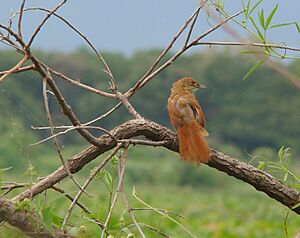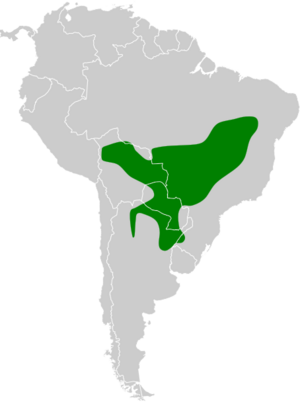Greater thornbird facts for kids
Quick facts for kids Greater thornbird |
|
|---|---|
 |
|
| Conservation status | |
| Scientific classification | |
| Genus: |
Phacellodomus
|
| Species: |
ruber
|
 |
|
The greater thornbird (Phacellodomus ruber) is a type of bird. It belongs to the ovenbird family called Furnariidae. You can find this bird in several South American countries. These include Argentina, Bolivia, Brazil, Paraguay, and Uruguay.
Contents
About the Greater Thornbird
The greater thornbird is a unique species. This means it does not have different subspecies. It is closely related to the freckle-breasted thornbird. They are like "sister species" in the bird world.
What Does the Greater Thornbird Look Like?
The greater thornbird is a medium-sized bird. It is about 19 to 21 centimeters (7.5 to 8.3 inches) long. It weighs around 35 to 51 grams (1.2 to 1.8 ounces). It is the heaviest and reddest thornbird. Both male and female birds look the same.
Adult birds have a reddish-brown or grayish-brown face. They have a lighter stripe above their eye. Their cheeks are whitish. The top of their head is reddish-chestnut with light streaks. Their back is a rich reddish-brown or olive-brown. Sometimes, it turns chestnut lower down. Their rump is a lighter reddish-brown. The feathers above their tail are chestnut.
Their wings are mostly rufous-chestnut. Their tail is reddish-chestnut. The throat is whitish. Their chest is pale with a light brownish color. The belly is whitish. The feathers under their tail are light reddish-brown. Their eyes are light yellow to orange. Their upper beak is dark. The lower beak is pale gray. Their legs and feet are gray or olive. Young birds have a less clear patch on their head. They also have brownish spots on their chest.
Where the Greater Thornbird Lives
The greater thornbird lives in many parts of South America. You can find it in north-central and eastern Bolivia. It also lives in Brazil, from the east to western Pernambuco and Bahia. Its range goes south into Rio Grande do Sul. It is found through central Paraguay into northern Argentina. It reaches as far as Corrientes Province. It also lives in western Uruguay.
This bird likes different kinds of places. It almost always lives near water. You might see it in thick bushes along rivers. It also lives in gallery forest (forests along rivers). It can be found at the edges of marshes and in scrublands. It usually lives at elevations between 300 and 1100 meters (980 to 3600 feet). In some parts of Bolivia, it can be found as high as 1400 meters (4600 feet).
Greater Thornbird Behavior
How the Greater Thornbird Moves
The greater thornbird stays in its home area all year long. It does not migrate to other places.
What the Greater Thornbird Eats
The greater thornbird eats many different kinds of arthropods. Arthropods include insects and spiders. It usually hunts for food in pairs. It finds its prey by picking it off the ground. It also picks food from plants in the lower parts of the forest.
Reproduction and Life Cycle
The greater thornbird breeds during the spring and summer in the Southern Hemisphere. This is usually from September to January or even later. It builds a nest shaped like a cone. The nest is made of thorny twigs and branches. It can be about 60 centimeters (2 feet) high. It can be 50 centimeters (1.6 feet) wide at the bottom. The bird lines the inside with soft plant material and feathers.
It hangs its nest from a tree or shrub branch. The nest is usually 1 to 3 meters (3 to 10 feet) above the ground. Often, the nest hangs over water. A female bird usually lays three to four eggs. Sometimes, she might lay a fifth egg. We don't know how long the eggs take to hatch. We also don't know how long it takes for the young birds to leave the nest. Details about how the parents care for their young are also not fully known.
Greater Thornbird Sounds
The greater thornbird's song is a series of loud, sharp notes. It can sing up to 20 notes. The song starts very high and strong. Then, it gets a little faster and goes down in pitch. You could describe it as "poo tew tew tew too too tootootoochoochew". Pairs of birds often sing together.
Its calls include a loud, high "djeub-djeb-djebdjed". It also makes sharp "check check" and "chweet" sounds.
Conservation Status
The IUCN (International Union for Conservation of Nature) has evaluated the greater thornbird. They have listed it as a species of "Least Concern". This means it is not currently in danger of extinction. It lives in a very large area. However, we don't know how many greater thornbirds there are. Scientists believe their numbers might be going down. No immediate threats have been found for this bird. It is considered uncommon to common in its range. It also lives in several protected areas.


